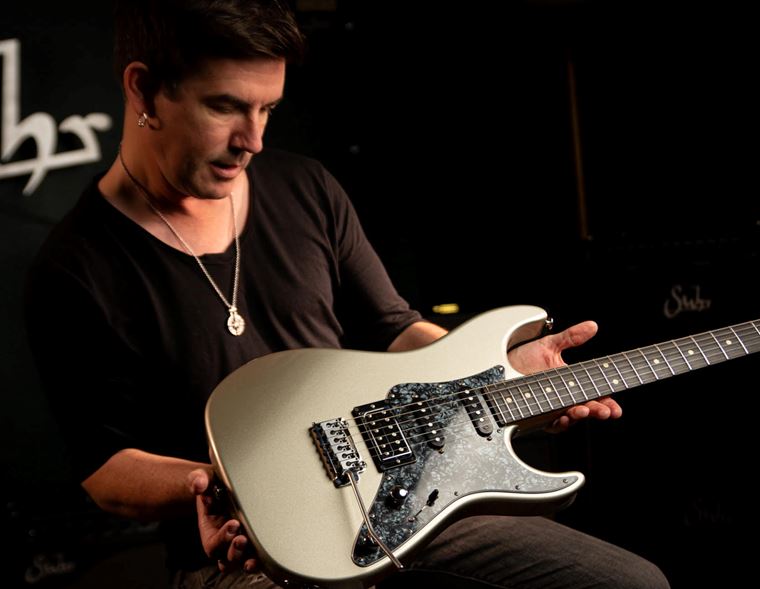JEORGE TRIPPS Talks about the MXR Poly Blue Octave! EXCLUSIVE Interview
Published on 17 February 2022
Whenever we get an opportunity to talk to Jeorge Tripps, we quickly say ‘YES!’
Apart from being really interesting and knowledgeable, he’s also a total hoot to talk to, so any excuse for a chat is worth chasing up.
For those who know of Tripps, he needs no introduction, but for those who don’t recognise the name, Jeorge is one of the most respected and celebrated pedal designers in the business. He started Way Huge pedals back in 1995, before there was really anything like a ‘boutique pedal’ market. Way Huge and Analog Man pretty much invented the notion of custom made effects that went beyond the familiar in terms of sonic potential.

(Photo: Andy Haldane)
Jeorge is now one of the top people at Dunlop, and looks after not only Way Huge but also MXR and Crybaby designs, amongst a small team of other designers. Our occasion to speak with Jeorge occurred when we recently got hold of the new MXR Poly Blue Octave pedal, a new design of Tripps’. Simple to look at it may well be, but there is a fascinating amount of wild sounds in there just waiting to be uncovered by intrepid sonic explorers. As they say, there’s a lot going on under the hood, and we figured there was no better person to ask about it all than the very man who designed it in the first place! Jeorge kindly joined us on an early morning Zoom chat from his workspace in Los Angeles to chat about the design and operation of this most intriguing of pedals, as well as talking a little about his incredible Way Huge Atreides pedal and a bunch of other fun stuff.
We take up the tale after our customary greetings...
Jeorge Tripps Interview
guitarguitar: So, I guess one thing we don’t often get to ask pedal designers is: what was the actual inspiration behind wanting to make the Poly Blue Octave?
Jeorge Tripps: You know, we wanted to do a digital polyphonic octave, and it was really based around the old (MXR) Blue Box, which was a very synthy, weird, bizarro yet very cool octave thing. We wanted to do something that was more modern, but did a lot of the other things: polyphonic, the high octaves, all that kinda stuff. So that’s why it’s got a fuzz in it. And, as we developed it, stuff just sort of came along, like, ‘You know what? This would be really cool to add! Do we have enough time? Do we have enough space in the DSP to do this?’ So, it wasn’t ‘this is what it’s going to be’ from the very start, it was more like, ‘Hey, we need to do something that’s a modern version of the Blue Box, but polyphonic’.
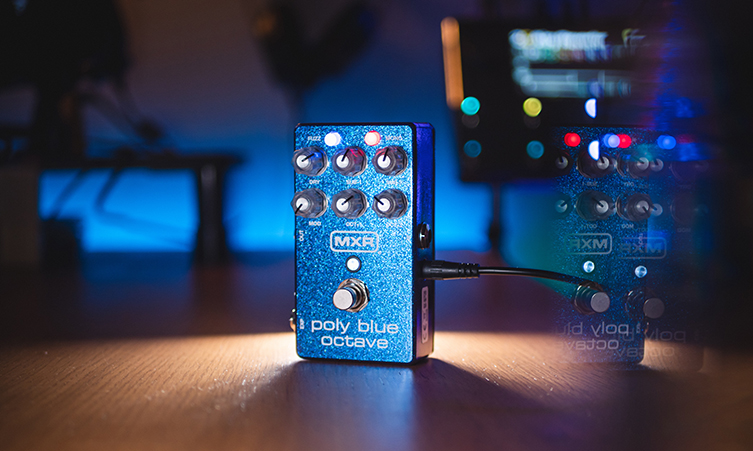
GG: Sure. Yeah, it seems like some of the fun of the Blue Box was that it was a wee bit unpredictable in the responses it could give.
JT: ‘Wee’ is putting it mildly (laughs).
GG: It seems to me that the tracking on the Poly Blue is highly accurate. What I wondered is if that’s something you can make a creative decision about? Like, within the circuit: do you get to decide how well you want it to react?
JT: To a certain degree. It’s all relative to space and then latency and things like that, so yeah. We looked at all the different polyphonic stuff out there, listened to them and this one sounds very different. That was the goal. It needed to sound more organic and less like space aliens (laughs). The way we did the polyphonic is different than other people’s.
GG: Cool! So, the octaves are one of the main things about it, but as you say, there’s a fuzz and there’s also modulation. Before we talk about the modulation, is the fuzz circuit an existing MXR fuzz sound, or is that something that’s been developed fresh?
JT: Well, we looked at a Blue Box, and that is very, very distinct. We wanted to get this close enough that you could get a Blue Box sound but also use this for other stuff. I have a tendency to use it set up as a kinda organ sound – with the fuzz on – and because there’s a noise gate on the fuzz which keeps the noise down, you can roll down the volume on your pickups and find a point where it becomes very interactive. It’s like an overdrive, and you can get very ‘Hammond-like’ organ sounds because you got a little distortion in there and you got modulation and all. Again, the goal was looking at the Blue Box and adding polyphony, then it just started to grow from there.
GG: Yeah, okay! And the modulation effect: lots of guitarists would use modulation with their octave effects, but you don’t often see one built into the same circuit. Was that something you guys just thought, ‘What if?’?
JT: Well, to tell you the truth, the very early DSP had this weird modulation to it, because it wasn’t tracking well enough. We actually tried to use that but it turned out to be terrible (laughs), so we ended up going, ‘This is starting to sound very organ-like. You know what would sound nice? A Leslie!’ So we did a quick Leslie sim to get it in that realm.
The other thing I’ve learned through the years of doing Leslie simulations is: guitar players don’t like Leslies. Very few have actually played through a real one. The issue is a real one doesn’t sound like your guitar amp anymore. What they want is, ‘I want my guitar amp, but I want it to swirl!’ But yeah, that’s not what a Leslie is (laughs). Most people have only heard recordings, and a Leslie is a whole different physical thing, you know? Guitar players want a Chorus that’s fast, that sounds like a Leslie.
GG: Yeah. Hahaha!
JT: At least, that’s been my findings, myself included! I love Leslies but it’s a different physical experience. Where it always ends for us is ‘let’s make this great for guitar players’: it’s a pedal and it’s going into an amp. We were like, ‘Damn, this is really good!’ Many times, we were saying, ‘this turned out better than I was hoping’, so that was a cool thing.
GG: Nice one.
JT: Especially the fuzz! The fuzz was...I was very apprehensive about it being digital. And it’s a really good sounding fuzz! (laughs)
"On this one, 'feature creep', as we call it, happened..."
GG: Haha, nice! So, thinking about it from a guitar player’s point of view outside the process, there’s fuzz, there’s the octaves and there’s the modulation. Inside the pedal itself, is there like an ‘inner chain’? If you switch on several of the effects, is there an order that the effects will all occur, as it were?
JT: Yes there is. There’s a block chain, essentially. Of the top of my head, I don’t remember where everything is at! I believe the pitch is before the fuzz, and the mod is probably after all of that, because you gotta modulate it. And the pitch first, because it would be tracking your initial note.
GG: Yeah, that makes sense!
JT: I haven’t seen it in a while, I finished making it like 7 months ago, haha! There’s to effects, essentially. There’s the polyphonic version and the monophonic version. Within those, there are multiple effects. It’s all the same fuzz! In the polyphonic, you’ve got the fuzz, then you’ve got a 4-octave voice and then a Leslie sim.
In the monophonic, you’ve got a fuzz, you’ve got a 4-octave voice but the two sub octaves are based on our Bass Octave Deluxe: analog, so it’s a monophonic sub octave. Then ‘up’ becomes a rectified signal, essentially an Octavia. Then the Leslie became a phase-shifter.
GG: Ahh!
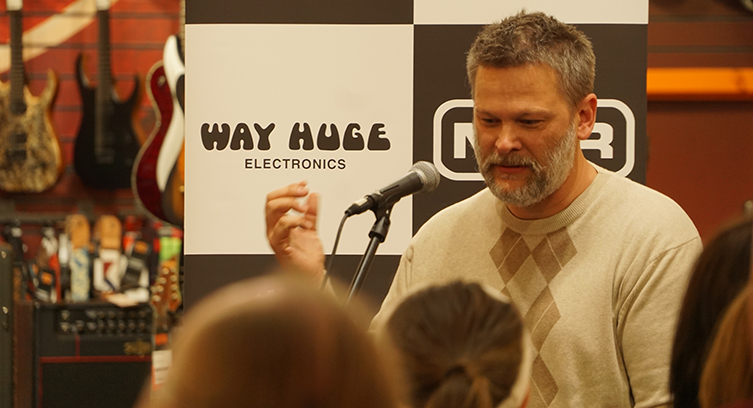
(Photo: Andy Haldane)
JT: It’s basically a completely different pedal. So you can have phase-shifty, sub-octave stuff in the monophonic, and then organ-ey, kinda other shit for the polyphonic. It has expression pedal control, where you can turn all the knobs and switch on the different buttons with the expression pedal. It’s definitely sort of two pedals.
GG: That’s amazing, that’s one of the things I hadn’t figured out: the difference in the mono mode. So, on that subject, you mentioned that the upper octaves become sort of rectified pitch-shifted Octavia sounds...
JT: Yeah, what an Octavia is, is literally rectifying a guitar signal; cutting it off. That’s what we did. If you just listen to it, it almost sounds broken, because that’s what rectified is, but it’s really neat because you can add other stuff. And, to do the high octave monophonic, it’s just terrible. This way is kinda cool because it does that thing, like an Octavia.
The other thing is, is if you think about this pedal almost like a mixing board. 5 of the knobs are literally blend knobs, so it’s just a mix. So, if you really want it to sound like an Octavia, you turn the ‘dry’ knob off, because you wouldn’t be getting dry signal. That’s what makes it sound broken, because you’re hearing clean guitar with rectified guitar. Turn the ‘dry’ off and all of a sudden it’s that Octavia, kinda steel drum sound. Add the fuzz in for that more synthy sounding thing.
"This is a painter's palette, to do what you choose."
The modulation is similar, where all the way down, it’s off and then you just bring up the speed. So, if you think about it that way, you’re just shaping a sound. Some people just turn everything up, but most of the time when you’re doing polyphonic, you need to have the dry signal in there unless you want it to sound synthetic.
GG: Just as an aside, one of the pedals I got most excited about recently was the Atreides Weirding Module.
JT: Oh, thank you!
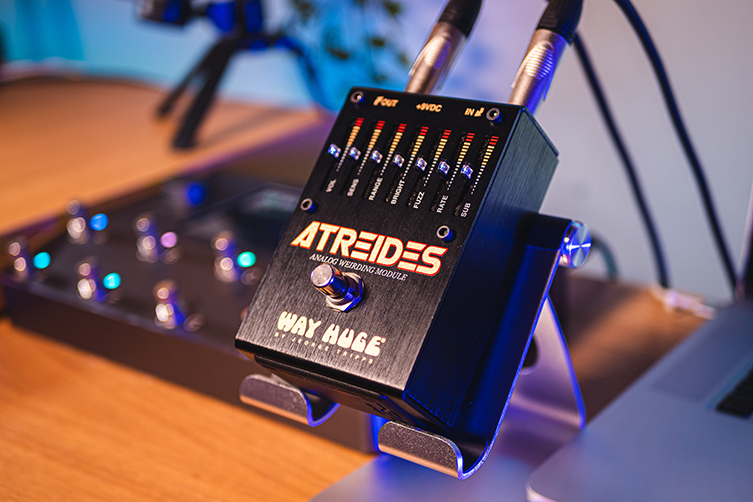
GG: It’s immense! It’s the kinda thing, when you’re learning to play guitar and you hear about effects pedals, you kind of expect all of them to be as bold and as full of impact as that one. Then you realise that about 90% of them are overdrives that kind of sound the same. It’s really nice to have something that’s not afraid to sound really quite ‘mental’.
JT: Yeah, well, that was really the whole point: to do something that’s different. It’d been something I’d been poking around on for years and years. I could never settle on it! (laughs) Normally, something that complex – because it’s got a lot going on – the first board won’t work. There was none of that with the Atreides, it was pretty cool.
You can get similar sounds out of the Poly Blue in monophonic mode. The main difference is there’s no envelope filter. That’s the big thing sonically. Are they the same? Not even close, but it’s got the sub octave, it’s got the fuzz, and there’s a phase shifter. It’s like, you’ve got an Atreides except for the envelope filter!
But that was a fun one. I was happy! You know, I had no idea whether people would like it or not, it was like throwing darts at the wall!
GG: I think it’s one of those ones that, in 20 years, other companies will do their version of the famous Way Huge Atreides Weirding Module.
JT: Hahahaha, maybe! You never know!
GG: That actually leads me on to one of the other things I wanted to ask you about. Now, I do not know how to build pedals, but you mentioned there about how the first finished circuit board for a design often won’t work and you have to start problem solving. I wondered: did you encounter issues or surprises or things you had to overcome to get the Poly Blue to be how you wanted it?
JT: No, because we were basing it off a platform that we already had with the tremolo and the Clone looper. The only thing that really had to change was the I/O, the knob circuit board. Luckily, there weren’t big...like, if we were developing a new platform, there would be a fuckin’ ton of that! It’s no fun. With prototypes, sometimes it’s not even an error that you did, it can be weird anomalies like, ‘Oh, they put the wrong part in!’, or shit like that. All sorts of stuff can happen.
GG: So I guess, just to round it off, you mentioned to me that you finished this pedal some months back and you’ve since moved on to work on new designs...
JT: I’ve literally got the final stuff for one project, then I’m gonna jump to something else. I’m usually working on half a dozen things at one time, if not more. It kinda depends, because between Way Huge, MXR and Crybaby, there’s always a bunch of stuff going on, and stuff will come in and out as we’re developing. And with the more complex stuff, we have to look farther ahead, you know? I know of at least six products, off the top of my head, that I’m working on in different stages.
"It needed to sound more organic and less like space aliens."
GG: Okay, and are any of those things that you are allowed to or willing to share with me?
JT: (laughs) No! Mostly because half of this stuff might not come out, or if it does, it might be a while before it comes out. You don’t want people expecting or wanting or what-have-you.
GG: Of course.
JT: If you could see down here (gestures to his desk, below the view of the camera), there’s all sorts of shit here that you’re not supposed to see!
GG: Damn!
JT: So yeah, nothing I can talk about. And there’s a handful of shit I’m not even involved with, like the Tom Morello overdrive, I haven’t even seen one of those!
GG: Really?
JT: Oh yeah, there’s only a handful of cats here and it’s like, ‘If you don’t need me, I’ve got plenty to do!’ (laughs)
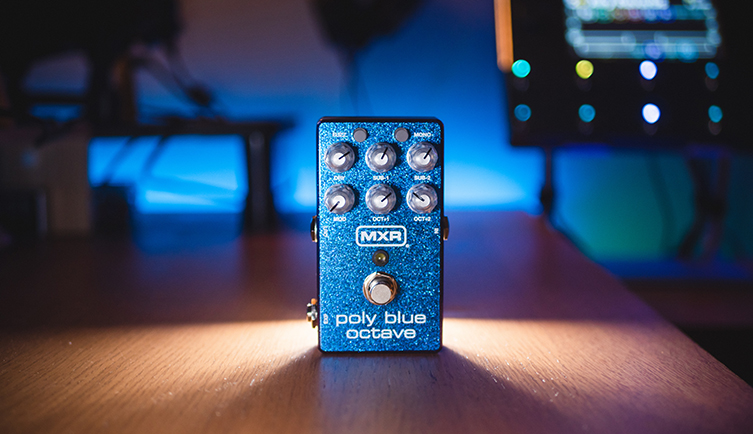
GG So, my last question would be: who is this pedal for?
JT: Well, it’s for a lot of people. People who want a polyphonic octave type of device, or soundscape dudes, because there’s a lot in there, it does a lot of shit. It was initially an ‘advanced Blue Box’, and then we added these features because, as we were using it, we kept thinking, ‘Well, it’d be cool to have this’. Like, the really early modulation didn’t sound good but we thought a Leslie would be great so added that. It just sort of became this thing. Again, it’s for a lot of people, and that wasn’t the original goal. It was to be a polyphonic octave thing, using the Blue Box as the base. Lots of stuff crept in, which is cool. Some products aren’t like that, some are: ‘This is what we’re making, we know what we’re doing, don’t change it’. On this one, ‘feature creep’ as we call it, happened. Feature creep near the end is like ‘we can’t go back, that’s taking us back six months...no’.
You can’t always think of everything, and stuff will come out anyway. I mean, once you look at this thing, it’s pretty simple to use, but at first glance it’s kinda like ‘How does this work?’ It’s actually really easy. I’ve had a lot of fun with it, and I’m not a polyphonic octave guy.
GG: Until now!
JT: I’m pretty good with a Fuzzface. I like ‘em! And I know how to use it. Simple. The Poly Blue was a lot of fun in the end. I just didn’t expect some of the cool shit that it does. The big thing I always say is, hey, turn the fuzz on and roll your volume back. Find that spot: you’ll hear it when the noise gate starts kicking in and it’s not, y’know, working right? There’s a spot right before that and it’s not fuzz anymore, it’s more like an overdrive. That starts opening up tonal doors! This is a painter’s palette to do what you choose.
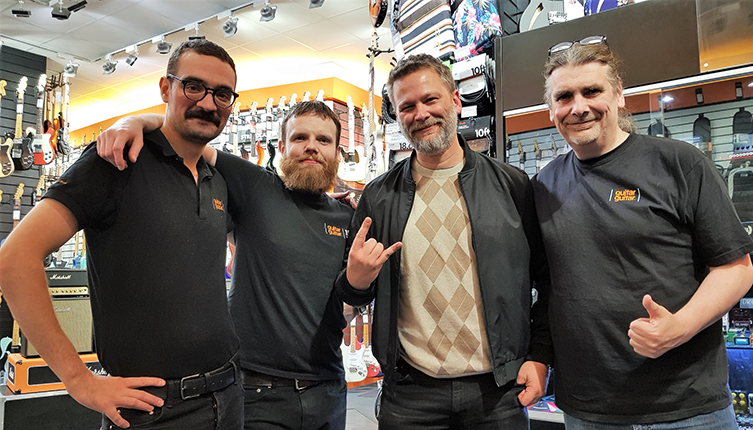
(Photo: Andy Haldane)
After that, our conversation moved onto other esoteric subjects such as Van Halen’s guitars and the famous Roland GR 700 synth guitar, one of which I spied hanging on Jeorge’s wall. The chat occasionally returned to the Poly Blue, with one particularly excellent remark by Jeorge being worth quoting here quite out of context – ‘It does this, it does that, it fuckin’ bakes potatoes!’ – and Jeorge conceding that a deeper explanation of the pedal was indeed worthwhile: ‘Some people are a little confused because there’s a lot going on. It looks simple but it can do a whole ton’.
Hopefully, this interview article has done just that. We’ve entered the mind of a pedal-making genius, had a root around in there, and come out the other end with a greater understanding of not only the working of this particular effect, but of its creator’s methodology and process.
The MXR Poly Blue Octave is available now and is well worth a look if you want to inject some creative excitement into your playing. Follow Jeorge’s advice or just do your own thing: you might uncover something completely new! We’d like to thank Jeorge for giving us such a great conversation, and to Andy at Westside for the ‘action’ pics of Jeorge’s visit to our Glasgow guitarguitar store.







